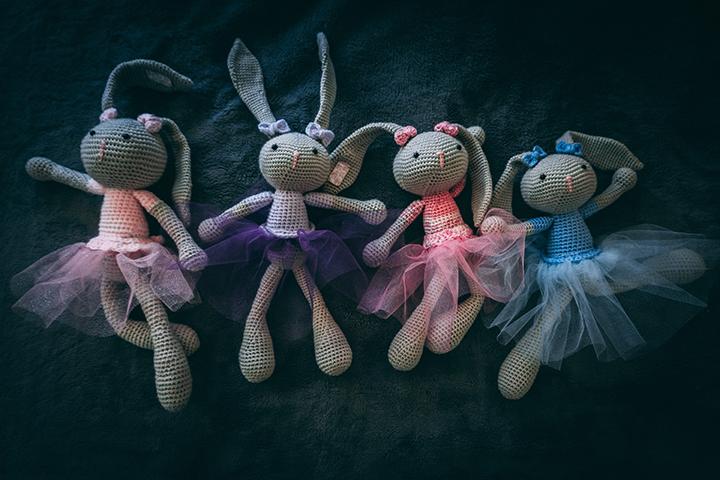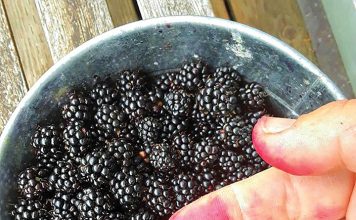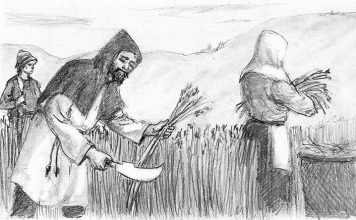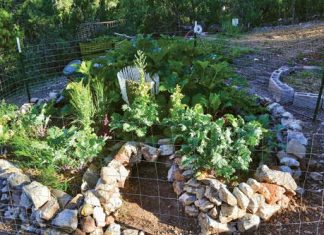| Issue #72 • November/December, 2001 |
The garden needs planting, animals need feeding, Baby needs to nurse, and that chicken coop simply has to be finished but, there are three children who want you to drop everything and have some fun with them. What you need is more time. Traditional homestead toys are the only answer. Quick, simple, economical, and tons more fun than Nintendo or the “Net.”
|
Whimmy diddle
Chop and whittle three pieces of firewood. The main piece should be about seven inches long, and so should the rattle stick. Propeller should be a thin sliver of wood about 1½ inches long by about ¼ inch wide with a hole drilled in the center. To find the center, balance the prop piece on the blade of your knife. Loosely nail propeller into tip of notched wood as in photo. Notches should be made on about 3 to 3½ inches of the whimmy diddle stick. The measurements are not very important. In fact, the most important aspect of this project is that the propeller is very light and swings freely on its nail.
To use your whimmy diddle simply rub your rattle stick quickly up and down the notched surface on the propeller stick which needs to be horizontal. The trick to making it work is in applying finger pressure to the sides of the propeller (notched) stick while rubbing it. With practice you can make the propeller change direction with only a slight shift in pressure. It looks like magic. The firewood whimmy diddle is a very simple project and a good one for a young person, with responsible, knowledgeable, adult supervision to practice knife control on. Successful results can be had with forest-found sticks and commercial dowels as well.
Braided doll
Wrap yarn 40 times around a book or something else that works. Size of object is unimportant. A bigger book will make a bigger doll.
Tie with contrasting color just in from one end of a bundle. This creates hair. You can choose the length of hair by tying bundle closer to or farther from the end. Wrap same color around a small object for arms 15 to 20 times. Tie contrasting color yarn tightly around bundle just in from each end. This creates hands. Open up the body bundle in about the center and insert arms through. Tightly bind with contrasting color over the chest and abdomen area. If the doll is a girl, you’re done. If you wish to make a little boy, separate two legs and bind tightly at the ankles.
Garden felt board
This is such a fun and simple project that you’ll wonder why you never did it before. Simply cut the piece of finished (smooth) hardboard or plywood to the dimension of a full piece of felt. The size of felt varies so you’ll have to check locally. Use a garden color, green or brown, for the board and from there cut out flowers, vegetables, plants, sky, sun, birds, animals, barn or house, forest, or wild animals. Use your imagination. It is amazing that even very young children (one or two years old) love this project. By adding a frame around board or putting on a different color background this project can become significantly more elaborate.
Hazelnut babies
Epoxy two Hazelnuts together. Be sure that the clear brown part of the nut lies where the face will be. Let the nuts sit overnight to cure. Cut felt of any color to one by three inches for the cloak, and a piece of yarn or cord for the scarf. Assemble so that they look like photo. At this point a face can be added with the felt tip marker if desired. For older children (four and older) most of this work can be self-directed. These make fantastic gifts and really cute Christmas decorations. These are fairly traditional Scandinavian craft, although today they are mostly made with wooden beads, which work admirably as well.
Buzz toy
These are probably the most familiar of all the traditional homestead toys. Many of us will have enjoyed button-on-a-string as a child at Grandma and Grandpa’s. They are also simplicity themselves to make and take but a minute. You need a 36-inch length of string or heavy coat thread, and a coat button of a fairly large size with two or four holes (not the type with the loop or shank on the back). Thread the button on to the strings like this:
That’s it, you’re done. Grasp one end with each hand, fingers through the loops, and swing it until the cord is twisted. Now, rhythmically, but gently, pull and let slack, pull and let slack. If you’re doing it correctly the toy will start buzzing and the rhythm will continue. If not, keep trying. Instead of a button, you can use a 1/8-inch plywood disk or heavy cardboard disk. The more mass the disk has the heavier the cord can be and the longer the spin lasts, so try experimenting.
Now, chores are done, children happy and content, it’s time for you to play. Try all of these toys and experience a very basic joy, both of playing and of providing your very own entertainment.



















